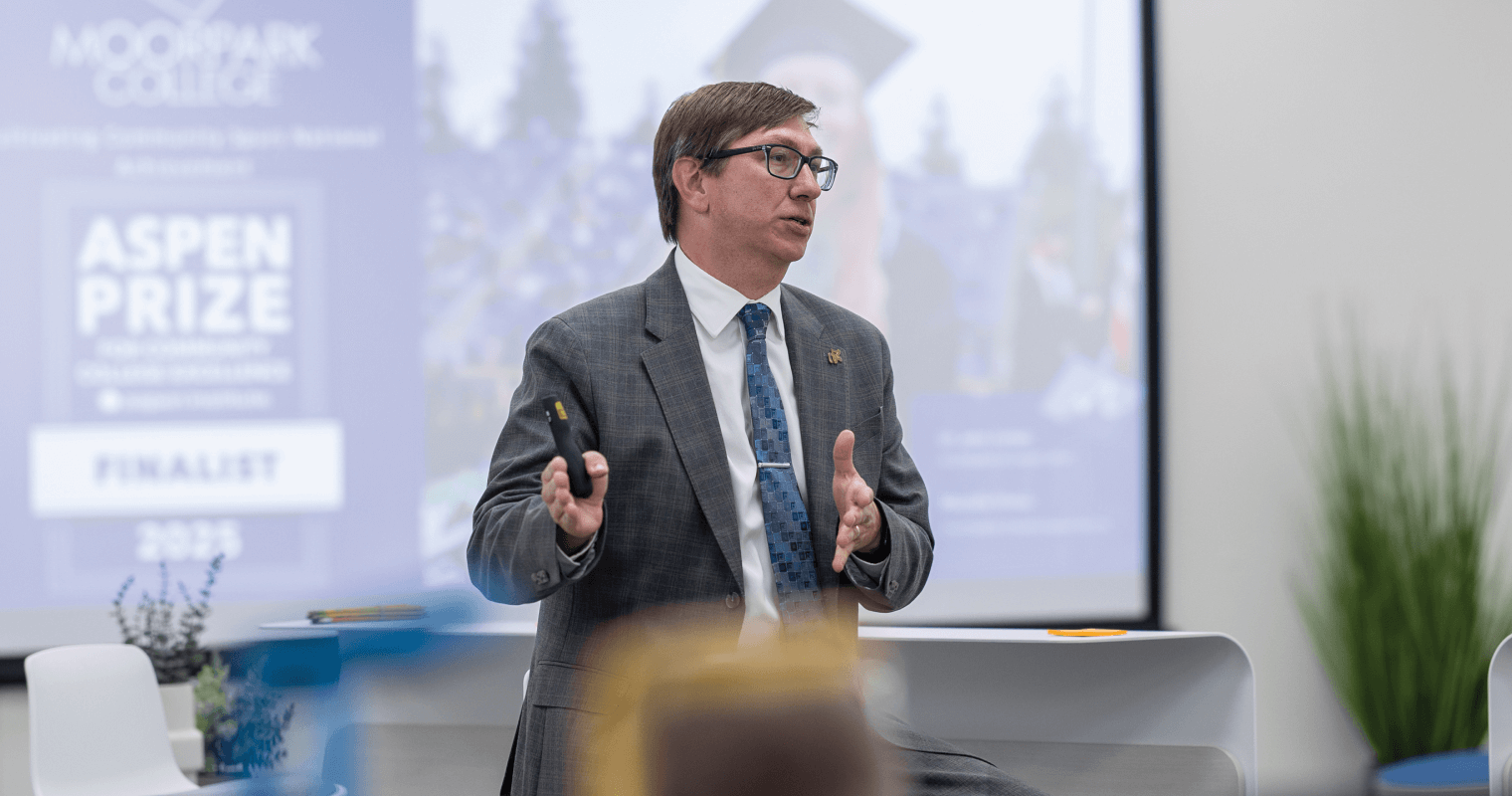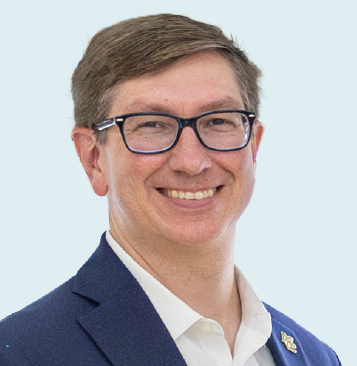A Conductor of Partnerships: Dr. Tom Nevill on Innovation and Apprenticeships at GateWay Community College
Located in the metropolis of Phoenix, Arizona, GateWay Community College is at the center of both growing industries and a growing population.


If you’re a community college student who intends to transfer to a four-year university, how likely is that to actually happen?
In the United States, approximately only 1 in 3 students successfully transfer.
However, Moorpark College is one institution beating the odds. Located in Moorpark, CA, Moorpark College is recognized as a leader for their commitment to student outcomes and transfer success. They were a Top 10 Finalist for the Aspen Prize in 2025 and were recognized as a Champion of Higher Education for Excellence in Transfer by The Campaign for College Opportunity (CCO) in 2023.
Dr. John Forbes, Vice President of Academic Affairs at Moorpark College, recently shared his perspective on the operational work going on behind the scenes that contributes to the college’s success. He spoke on a variety of topics, including creating successful transfer programs, empowering your staff, and approaching conversations around AI.
Transferring from a community college to a four-year institution has historically been fraught with complexities, often leading to wasted credits and prolonged academic journeys. Moorpark College tackled this head-on by embracing the Associate Degree for Transfer (ADT) framework, a legislative initiative designed to streamline the process for California community college students aiming to transfer to the California State University (CSU) system.
“We’re known nationwide and within the state as very good at transfer,” explains Dr. Forbes. “Our students have very clear pathways within academic disciplines and then transfer to four-year institutions.” He emphasizes that success isn’t just about getting students admitted; it’s about their preparedness post-transfer. “We’ve also been known for having high success after transfer, which is something you want to look at. It’s not just getting someone across the finish line and getting that diploma, but once they go on to a four-year school, how well prepared are they for earning a bachelor’s degree—which is a big deal in today’s economy.”
The key to this success lies in the proactive adoption of ADTs. Over a decade ago, Moorpark College’s faculty swiftly realigned their local associate degrees to match the Transfer Model Curricula (TMCs) developed by the CSUs. “The course itself and the progression matches because then the ADT is a guarantee—that’s the legislation’s idea—that the student then enters the CSU system as a junior,” Dr. Forbes states. “They’re not repeating courses. There wasn’t some random business department at a particular CSU that said ‘Oh, we didn’t like the order you took something in.’” This alignment has significantly reduced the friction points that once plagued transfer students.
Part of setting up the right infrastructure for success lies in evaluating how well institutional policies serve students. Dr. Forbes believes that at the heart of it, “any system that’s creating a policy that doesn’t center the student is in the wrong.” He points to outdated policies, like the punitive language surrounding academic probation.
Moorpark ran a trial where they changed the name to “academic notice” in all of their notices, letters and emails. Just as important, it added “the type of language that was more growth mindset and helped a student understand that we want you to persist,” Dr. Forbes explained. Instead of threatening students with “probation,” the college adopted an encouraging tone. This shift aims to encourage students to access support services rather than getting the same undesirable result. “It’s like saying ‘Don’t just keep signing up for that same class and failing it over and over again.’ We have to do something different,” he concludes.
To continually improve student outcomes, institutions are constantly investigating new programs and initiatives that can help students succeed. However, getting the approval and budget to test a new idea is easier said than done. When it comes to securing funding and support for new projects, Dr. Forbes is a proponent of data-driven proposals and a clear theory of action. He describes himself as a “come back with more” person,” emphasizing the need to bring the right data and information. He asks his staff: “What’s the data structure? In other words, how many students are we talking about?”
Dr. Forbes also prioritizes careful design and measurable outcomes. “Moorpark College is known for designing better on the upfront—whether we think something would work, whether we can see a causal impact of the intervention,” he explains. He cites examples like their two-way texting initiative and course embedded tutors, both of which were meticulously planned to evaluate their effectiveness. “Because we carefully designed a comparison from the get-go on what variables would be different across a semester, we were then able to point back to where there was a casual relationship for our course embedded tutors,” he explained.
A compelling proposal, according to Dr. Forbes, needs a strong theory of action grounded in research. “This isn’t just something that somebody dreamed up. If we’re academics, we should stand on the shoulders of giants and we should use academic research to know whether something has worked in the past or not.” He often encourages proposers to refine their ideas. “I’m sometimes known as the ‘go back and try again’ person. But then let’s plan it, vote, and as a partnership figure out what really works.”
He illustrates this with the example of course-embedded tutoring. From the start, the program wasn’t just “Here’s a tutor, good luck,” but a thoughtful approach that included study skills workshops and two-way
texting. This meticulous planning allowed for the demonstration of causal relationships and ultimately led to proven success.
Like many colleges and universities, administrators at Moorpark are investigating what role artificial intelligence plays in higher ed. However, due to the multi-faceted nature of AI, it is easy for discussions to quickly get derailed. Dr. Forbes advocates for a structured approach to conversations surrounding AI.
“Talking about AI is like saying ‘let’s talk about air.’ You can breathe it, store it, use it,” he observes. To avoid unproductive discussions, he suggests defining AI’s impact in “buckets.” These could include academic honesty, content creation, tutoring, and operational uses like scheduling and enrollment management. “Put it in a bucket so that you’re not just walking into a conversation or committee meeting and someone says ‘What about AI?’ And then suddenly we’re 40 minutes into talking about five or six different things about AI and no one’s solving anything.”
Beyond AI policies on academic integrity, institutions must consider the workforce demands. “We’re hearing overwhelmingly from a number of employers that they don’t want to hire anybody, from an English major to biotech manufacturing, who doesn’t know the relevant tools in that industry or in that sector of AI and how to use them,” Dr. Forbes emphasizes. Examples of relevant AI skills include prompt engineering, data interpretation, and automation. He posits that dismissing AI entirely would be a disservice to students. “If we don’t have a policy that centers on the student and just says ‘no AI’, then we’re going to miss out.”
Ensuring students are well-prepared for their next academic chapter goes beyond curriculum alignment. Supporting faculty and staff is also paramount. Dr. Forbes believes in empowering his team by eliminating unnecessary burdens and fostering collaboration. “Time is an important resource. Are people spending time on paperwork or a process that we could make more efficient? Let’s undo that and take that burden off,” he asserts. He highlights initiatives like focusing on mastery learning and standards-based grading in math, where he provides resources and support rather than dictating methods. “I don’t tell anyone what to do, but I resource what they want to do.” This includes important work like overseeing stipends to fund workshops and evaluating the outcomes. “Working with our dean of institutional effectiveness and looking at the data behind whether we’re actually seeing growth or not.”
Effective leadership also plays a role in fostering successful initiatives by ensuring clarity of purpose in group meetings. “When we’re working at our best, there’s clarity around why the group is meeting. That points back to leadership,” he says. Leaders should define the goal, rather than dictate the “how.” He advocates for looking at larger targets such as completion and equity gaps among special populations.
Dr. Forbes acknowledges the perennial challenge of resource constraints but emphasizes a proactive mindset.
“We can always complain about how under-resourced we are, but we are given time, money, and people. I try to find the right recipe to keep people focused on what really matters, which is helping students learn from a wide variety of backgrounds and progress on their career paths.”
Ultimately, Dr. Forbes aims to help keep his staff focused on what matters, even in the midst of ever-changing policies, regulations, and new memos being issued. “The students who walked in your door yesterday haven’t changed today…It’s all the same: What are you doing to help students learn the content you’ve been entrusted with? It’s for all students.”